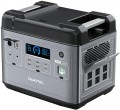Add to comparison |  |  |
|---|---|---|
| Oukitel P2001 | Choetech BS006 | |
| Compare prices 1 | from $1,179.36 | |
| TOP sellers | ||
2 USB A ports, 2 USB A Fast Charge ports, 2 USB C ports. LiFePO4 – Lithium Iron Phosphate Battery. Surges up to 4000 W are allowed. Battery capacity is 2000 Wh. | 2 USB A ports, 2 USB A QC3.0 ports, 2 USB C ports. Car cigarette lighter, 2 DC5521 ports. LiFePo4 battery 1997 Wh. | |
| In box | charging station | charging station |
| Rated power | 2000 W | 2000 W |
| Peak power | 4000 W | |
| Output waveform | sinusoid (PSW) | sinusoid (PSW) |
| UPS function | ||
Outputs | ||
| Sockets (230 V) | 3 | 3 |
| USB A | 2 5В/2.4А 12 W | 2 5В/2.4А 12 W |
| USB A (quick charge) | 2x QC3.0 18 W | 2x QC3.0 18 W |
| USB C | 2 5 A 100 W | 2 5 A 100 W |
| Car cigarette lighter | ||
Inputs (station charging) | ||
| From solar panels | ||
| Input port XT60 | ||
| Anderson port | 12 – 48 H / 15 A | 11.5 – 50 H / 500 W |
| Add. ports | C13/14 (charging) | C13/14 (charging) |
Battery and charging time | ||
| Battery type | LiFePO4 | LiFePO4 |
| Battery capacity | 2000 W*h | 1997 W*h |
| Charging cycles | 3500 | |
| Charging time (socket) ≈ | 108 min | 120 min |
| Charging time (solar panel) ≈ | 240 min | 300 min |
| Charging power (socket) | 1100 W | 1100 W |
| Charging power (solar panel) | 500 W | 500 W |
General | ||
| PSU | built into the body | |
| Display | ||
| Backlight | ||
| Carrying handle | ||
| Operating temperature | 0 °C ~ +40 °C | -10 °C ~ +40 °C |
| Dimensions | 394x279x330 mm | 386x275x306 mm |
| Weight | 22 kg | 22 kg |
| Warranty | 3 years | 2 years |
| Added to E-Catalog | february 2023 | january 2023 |
The Oukitel P2001 and Choetech BS006 charging stations have similar characteristics but differ in some key aspects. Both models offer a nominal power of 2000 W and a sine wave output, however, the Oukitel P2001 stands out with a higher peak power of 4000 W, allowing for the connection of more powerful devices. The charging time for the Oukitel from the mains is about 108 minutes, while the Choetech requires about 120 minutes. Users note that both stations have convenient carrying handles and displays, but the Oukitel offers a longer battery life with 3500 charging cycles compared to 1997 Wh for the Choetech. On the other hand, Choetech features a wider range of operating temperatures, which can be an advantage in cold conditions. Choosing between them depends on your needs: Oukitel is better suited for more intensive use, whereas Choetech may be preferable for less demanding tasks.